Related Research Articles

In Western classical music, a motet is mainly a vocal musical composition, of highly diverse form and style, from high medieval music to the present. The motet was one of the pre-eminent polyphonic forms of Renaissance music. According to Margaret Bent, "a piece of music in several parts with words" is as precise a definition of the motet as will serve from the 13th to the late 16th century and beyond. The late 13th-century theorist Johannes de Grocheo believed that the motet was "not to be celebrated in the presence of common people, because they do not notice its subtlety, nor are they delighted in hearing it, but in the presence of the educated and of those who are seeking out subtleties in the arts".

Josquin Lebloitte dit des Prez was a composer of High Renaissance music, who is variously described as French or Franco-Flemish. Considered one of the greatest composers of the Renaissance, he was a central figure of the Franco-Flemish School and had a profound influence on the music of 16th-century Europe. Building on the work of his predecessors Guillaume Du Fay and Johannes Ockeghem, he developed a complex style of expressive—and often imitative—movement between independent voices (polyphony) which informs much of his work. He further emphasized the relationship between text and music, and departed from the early Renaissance tendency towards lengthy melismatic lines on a single syllable, preferring to use shorter, repeated motifs between voices. Josquin was a singer, and his compositions are mainly vocal. They include masses, motets and secular chansons.
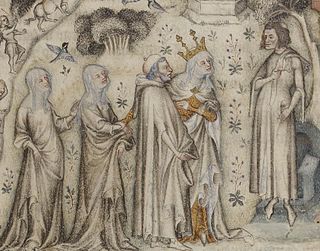
Guillaume de Machaut was a French composer and poet who was the central figure of the ars nova style in late medieval music. His dominance of the genre is such that modern musicologists use his death to separate the ars nova from the subsequent ars subtilior movement. Regarded as the most significant French composer and poet of the 14th century, he is often seen as the century's leading European composer.

Gilles de Bins dit Binchois was a Franco-Flemish composer of early Renaissance music. A central figure of the Burgundian School, Binchois and his colleague Guillaume Du Fay were deeply influenced by the contenance angloise style of John Dunstaple. His efforts in consolidating a 'Burgundian tradition' would be important for the formation of the Franco-Flemish School. One of the three most famous composers of the early 15th century, Binchois is often ranked behind Du Fay and Dunstable by contemporary scholars, but his works were still widely cited, emulated and used as source material after his death.

Guillaume Du Fay was a French composer and music theorist of the early Renaissance. Considered the leading European composer of his time, his music was widely performed and reproduced. Du Fay was well-associated with composers of the Burgundian School, particularly his colleague Gilles Binchois, but was never a regular member of the Burgundian chapel himself.

Isorhythm is a musical technique using a repeating rhythmic pattern, called a talea, in at least one voice part throughout a composition. Taleae are typically applied to one or more melodic patterns of pitches or colores, which may be of the same or a different length from the talea.
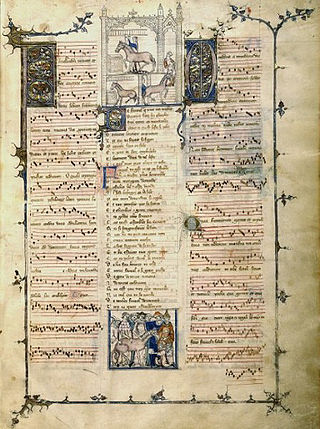
Ars nova refers to a musical style which flourished in the Kingdom of France and its surroundings during the Late Middle Ages. More particularly, it refers to the period between the preparation of the Roman de Fauvel (1310s) and the death of composer Guillaume de Machaut in 1377. The term is sometimes used more generally to refer to all European polyphonic music of the fourteenth century. For instance, the term "Italian ars nova" is sometimes used to denote the music of Francesco Landini and his compatriots, although Trecento music is the more common term for the contemporary 14th-century music in Italy. The "ars" in "ars nova" can be read as "technique", or "style". The term was first used in two musical treatises, titled Ars novae musicae by Johannes de Muris, and a collection of writings attributed to Philippe de Vitry often simply called "Ars nova" today. Musicologist Johannes Wolf first applied to the term as description of an entire era in 1904.

Antoine Busnois was a French composer, singer and poet of early Renaissance music. Busnois and colleague Johannes Ockeghem were the leading European composers of the second half the 15th century, and central figures of the early Franco-Flemish School.
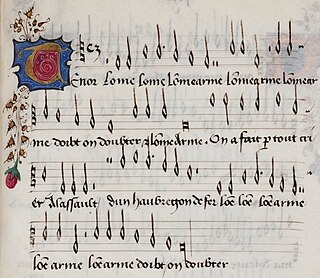
"L'homme armé" is a secular song from the Late Middle Ages, of the Burgundian School. According to Allan W. Atlas, "the tune circulated in both the Mixolydian mode and Dorian mode ." It was the most popular tune used for musical settings of the Ordinary of the Mass: over 40 separate compositions entitled Missa L'homme armé survive from the period.
Nicolas Grenon was a French composer of the early Renaissance. He wrote in all the prevailing musical forms of the time, and was a rare case of a long-lived composer who learned his craft in the late 14th century but primarily practiced during the era during which the Renaissance styles were forming.
Johannes Regis was a Netherlandish composer of the Renaissance. He was a well-known composer at the close of the 15th century, was a principal contributor to the Chigi Codex, and was secretary to Guillaume Dufay.
Jacob Senleches was a Franco-Flemish composer and harpist of the late Middle Ages. He composed in a style commonly known as the ars subtilior.
Cleofa Malatesta da Pesaro was an Italian noblewoman and the wife of Theodore II Palaiologos, Despot of the Morea, brother of Constantine XI, the last Byzantine emperor. She was a daughter of Malatesta dei Sonetti, Count of Pesaro, and Elisabetta da Varano. She married Theodore Palaiologos in Mystras on January 21, 1421, or sometime in 1422 in an arranged marriage that was part of an initiative of her uncle, Pope Martin V, to join Western with Orthodox nobility, who in this way hoped to gain political alliances against the Ottoman Turks.
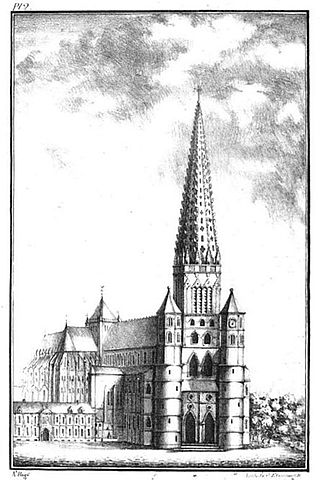
Old Cambrai Cathedral was the Gothic cathedral of the diocese of Cambrai in France, sited on what is now Place Fénelon in Cambrai but now entirely lost. Recorded as one of the largest and finest architectural monuments in northern France, it was replaced by the current Cambrai Cathedral.

David Fallows is an English musicologist specializing in music of the late Middle Ages and early Renaissance, as well as the performance practice of music. He is a leader in fifteenth-century music studies, particularly secular song, Guillaume Dufay, and Josquin des Prez, both the subject of landmark biographies Fallows has written.
Gilet Velut was a French composer of the early Renaissance.
This is a list of notable events in music that took place in the 1470s.
This is a list of notable events in music that took place in the 1410s.
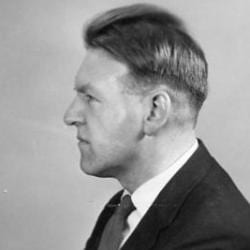
Gilbert Reaney was an English musicologist who specialized in medieval and Renaissance music, theory and literature. Described as "one of the most prolific and influential musicologists of the past century", Reaney made significant contributions to his fields of expertise, particularly on the life and works of Guillaume de Machaut, as well as medieval music theory.

The American Institute of Musicology (AIM) is a musicological organization that researches, promotes and produces publications on early music. Founded in 1944 by Armen Carapetyan, the AIM's chief objective is the publication of modern editions of medieval, Renaissance and early Baroque compositions and works of music theory. Among the series it produces are the Corpus mensurabilis musicae (CMM), Corpus Scriptorum de Musica (CSM) and Corpus of Early Keyboard Music (CEKM). In CMM specifically, the AIM has published the entire surviving oeuvres of a considerable amount of composers, most notably the complete works of Guillaume de Machaut and Guillaume Du Fay, among many others. The CSM, which focuses on music theory, has published the treatises of important theorists such as Guido of Arezzo and Jean Philippe Rameau. The breadth and quality of publications produced by the AIM constitutes a central contribution to the study, practice and performance of early music.
References
- 1 2 3 4 5 6 Reaney 2001.
- ↑ Planchart 1993, pp. 357–59.
- ↑ Kim 1990, p. 41.
- ↑ Fallows 1987, p. 249.